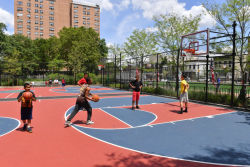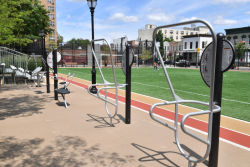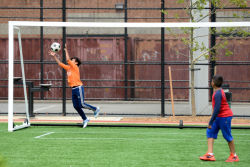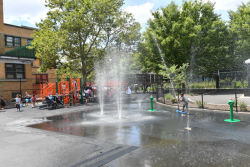Heckscher Playground
The Daily Plant : Wednesday, July 16, 2003
CENTRAL PARK: A HISTORY
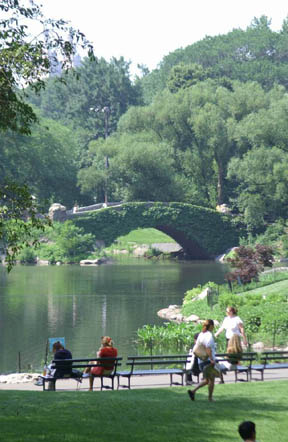
This Saturday, July 19th New Yorkers will celebrate the 150th anniversary of Central Park with a day full of festivities. What many might not now, however, is exactly what happened 150 years ago that led to the creation of the best urban park in the world. Below is a brief history of Central Park.
In 1853, the New York State Legislature authorized the City of New York to buy a parcel of land from 59th to 106th Streets and from Fifth to Eighth Avenues. Three years later, the City acquired the site and adopted a park plan developed by Egbert Viele, chief engineer of the park. In 1857 Frederick Law Olmsted was appointed Superintendent of the park and the state-appointed commissioners of the park announced a competition for design of the park. Olmsted was approached by Calvert Vaux, a London-born architect, to collaborate on a design. Their submission, which they named the Greensward Plan, was selected as the winning entry for the design of the park. Four sunken transverse roads, an ingenious feature in the original design, screen and separate east-west cross-park traffic.
The first tree was planted in Central Park on October 17, 1857. The Park opened in December when the Lake was completed, and people flocked to the Park to ice skate. A few years later, in 1863, the park was extended from 106th Street to 110th Street through the purchase of the rocky and swampy land.
The New York Meteorological Observatory began taking readings from the roof of the Arsenal at 64th Street and Fifth Avenue, the offices of the Park administration, in 1868. The Arsenal, which predates the Park, was originally built as a storage repository for munitions and was completed in 1851.
Bethesda Fountain, also known as the Angel of the Waters, by Emma Stebbins, was dedicated on May 31, 1873. It was the only sculpture commissioned as part of the design of the Park.
To create the Park and its landscapes, 20,000 barrels of gunpowder were detonated; five million cubic yards of stone and earth was moved; and a half million cubic yards of top soil was spread to plant five million trees and shrubs.
In 1926, the 4.5-acre Heckscher Playground opened and it was the first feature in the Park to be funded by a private donor, philanthropist August Heckscher (grandfather of August Heckscher, Parks Commissioner from 1967 to 1972). This is the largest playground in the Park, and the first of its 21 playgrounds.
Some notable events through the years include: In 1931, the lower Croton Reservoir (now the Great Lawn) was drained. In 1934 the sheep were evicted from Sheep Meadow. In 1965 the Park was declared a National Historic Landmark.
On July 20, 1969 the first lunar landing, by Neil Armstrong and Buzz Aldrin, was televised on Sheep Meadow. In 1970, the first Earth Day celebration is held in the Park. In 1980, a group of concerned citizens, led by Elizabeth Barlow Rogers, establishes the not-for-profit Central Park Conservancy. The mission of the Conservancy is to restore, manage, and preserve Central Park, in partnership with the public, for the enjoyment of present and future generations.
On Friday, The Daily Plant will list the schedule of events for Saturday, July 19. New Yorkers of all ages are encouraged to attend. For more information and a detailed history of the Park, please visit www.centralparknyc.org.
QUOTATION FOR THE DAY
"You cannot fight against the future. Time is on our side."
William Ewart Gladstone
(1809-1898)
Check out your park's Vital Signs
Clean & Safe
Green & Resilient
Empowered & Engaged Users
Share your feedback or learn more about how this park is part of a
Vital Park System

